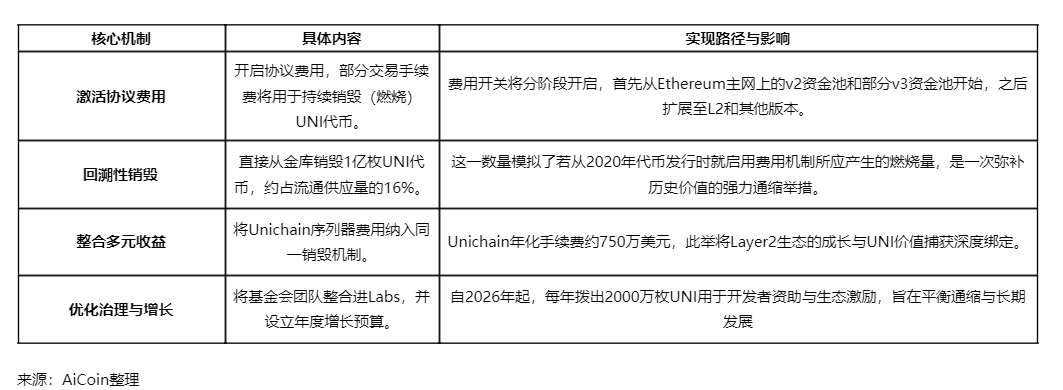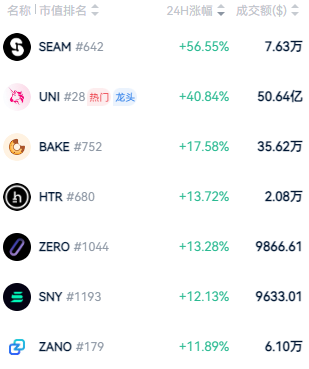On November 11, a governance proposal named "UNIfication" shocked the entire crypto world, as Uniswap for the first time granted real cash flow and deflationary expectations to its tokens, causing the UNI token to surge over 50%, igniting the entire DeFi sector.
The "UNIfication" governance proposal, jointly released by Uniswap Labs and the Uniswap Foundation, plans to activate a protocol fee mechanism and implement token burning.
This move is interpreted by the market as a key turning point for the UNI token, shifting from a purely governance token to a productive asset supported by cash flow, setting a new standard for value capture in the entire DeFi industry.

1. Breaking the Deadlock: Core Breakthrough of the UNIfication Proposal
After years of debate in the DeFi world regarding the "fee switch," Uniswap has finally proposed a comprehensive and systematic value capture plan that fundamentally changes the basic attributes of the UNI token.
● The "UNIfication" proposal introduces real cash flow and deflationary expectations for UNI through a multi-faceted approach. The core of the proposal is to initiate protocol-level fee distribution, directing a portion of transaction fees to the UNI burn pool, continuously reducing the token's circulation.
● This mechanism will first be implemented in v2 and v3 pools, and then expanded to L2 and future versions, building a complete value support system for UNI. The retrospective burning of 100 million UNI (approximately 16% of the circulating supply) is a significant one-time demonstration of determination to the market, simulating the amount that would have been burned had the fee mechanism been activated since 2020.

In addition to the core measures mentioned above, the proposal also introduces two clever mechanisms to enhance the protocol's revenue capacity:
● Protocol Fee Discount Auction: Users can bid to obtain "fee-free trading" privileges. This mechanism not only brings new capital inflow to the burn pool but also helps the protocol internalize MEV profits, thereby increasing returns for liquidity providers.
● Aggregator Hooks: In Uniswap v4, the protocol will upgrade to an on-chain aggregator, capable of charging fees from external liquidity sources and executing token burning logic, further expanding the potential scope of protocol revenue.
2. Mechanism Analysis: Four-Dimensional Value Restructuring
The UNIfication proposal constructs a complete token economic system through the design of four key mechanisms, bringing fundamental value restructuring to UNI and the entire DeFi sector.
The table below details the core measures and expected impacts of the proposal:

● Uniswap can allocate approximately $460 million in fees annually for the repurchase and burning of UNI, with an annualized deflation rate of about 5%. This data indicates that UNI is becoming the first "valued token" among DeFi blue chips, with valuation metrics of approximately 21 times earnings and 3.5 times sales.
3. Market Reaction: Sector Resonance and Value Discovery
After the release of the UNIfication proposal, the market reacted quickly and strongly.
● The UNI token surged over 50% within 24 hours, breaking the $10 mark, with a market cap exceeding $6 billion, re-entering the top 30 of crypto assets. This market performance far exceeded typical positive news events, reflecting a high recognition from investors regarding the revaluation of UNI.

● More importantly, the strong performance of UNI has driven resonance across the entire DeFi sector. Decentralized exchanges and DeFi tokens with similar value capture potential have generally attracted capital attention, demonstrating the market's high recognition of the "cash flow + deflation" model for DeFi projects.

This market performance of sector linkage suggests that DeFi may be transitioning from the era of purely "governance tokens" to that of "cash flow tokens."
4. New Era for DeFi: From Infrastructure to Economy
Uniswap's transition marks the evolution of DeFi protocols from "public infrastructure" to "sustainable economies," with significance that transcends the upgrade of a single project. This transition aligns perfectly with the overall trend of DeFi development towards 2025.
● DeFi infrastructure has matured, and regulatory frameworks are gradually clarifying, creating conditions for protocols to undergo such fundamental economic model transformations.
● Uniswap founder Hayden Adams noted: "In the past few years, we have gone through a harsh regulatory cycle and paid a heavy price, but now the environment is starting to improve. UNIfication marks a new phase for Uniswap, realigning the token, protocol, and community."
● From a broader industry perspective, power is shifting from centralized exchanges to transparent, code-driven platforms. When the next wave of market liquidity flows in, decentralized entities are expected to capture most of the value.
5. Challenges and Opportunities Coexist
Although the UNIfication proposal brings significant positive changes to Uniswap and the entire DeFi sector, the future remains full of challenges. The proposal still needs to be implemented through community governance voting by the Uniswap DAO, which carries uncertainty.
● Even if the proposal passes smoothly, balancing the deflationary mechanism with funding for ecological development is also a major challenge. The proposal plans to allocate 20 million UNI annually for developer funding and ecological incentives starting in 2026, which will somewhat offset the deflationary effects of the burn.
● From a market competition perspective, as the DEX leader with a cumulative trading volume exceeding $4 trillion, Uniswap's actions will undoubtedly set new standards for the entire DeFi industry. Other mainstream DeFi projects are likely to follow suit, launching similar token economic models, pushing the entire industry towards a more sustainable direction.
The table below compares the structural advantages of DeFi and CeFi, showcasing the future prospects of decentralized trading:

With the launch of the "UNIfication" proposal, DeFi is transitioning from the farming era reliant on inflationary incentives to the value era based on cash flow. The surge in UNI's price is not just a market reaction to a single event but a recognition of the evolution of the fundamental value model of DeFi.
When Uniswap founder Hayden Adams said, "UNIfication marks a new phase for Uniswap," he pointed to a grander future—DeFi is no longer just an imitator of traditional finance but a new generation of financial ecology that can sustain itself and continuously evolve.
Join our community to discuss and grow stronger together!
Official Telegram community: https://t.me/aicoincn
AiCoin Chinese Twitter: https://x.com/AiCoinzh
OKX benefits group: https://aicoin.com/link/chat?cid=l61eM4owQ
Binance benefits group: https://aicoin.com/link/chat?cid=ynr7d1P6Z
免责声明:本文章仅代表作者个人观点,不代表本平台的立场和观点。本文章仅供信息分享,不构成对任何人的任何投资建议。用户与作者之间的任何争议,与本平台无关。如网页中刊载的文章或图片涉及侵权,请提供相关的权利证明和身份证明发送邮件到support@aicoin.com,本平台相关工作人员将会进行核查。



